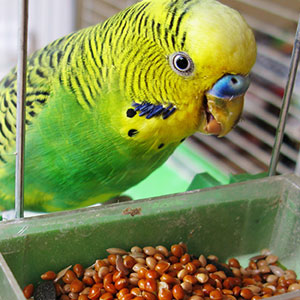
Pantry Moth Prevention
There's something buzzing around in here, and it's up to no good! Our culprit today is pantry moths, and they can cause huge problems for bird owners. We'll address the life cycle of pantry moths, explaining how they get into your house, how you can identify them, and how you can get rid of them! A couple of little moths may seem like a simple inconvenience, but keep reading to learn about the trouble they can cause!
The first sign of a pantry moth infestation is often an encounter with an adult moth - and believe us, that one seemingly innocent bug could be a sign of bad things to come.
A little backstory on your new frenemy. These pests may enter your home at any stage in their lifecycle - as eggs, larvae, or adults, often tucked away in sealed bags of food. They especially like bird seed, as it's made up of natural, unprocessed grains, nuts, and seeds. The bugs in your food bag grow: eggs hatch into larvae, who feed on the nutrient-dense food intended for your birds, and adults burrow out, looking for new places to lay their eggs. Consider this: most adult females can lay around 400 eggs – eggs that will eventually hatch, infesting another vulnerable or unsealed food container. All of this may be already happening when you see that first little moth flitting around your basement light.
Gulp.
So what's a parront to do?!
Moths in Bird Seed
First of all, don't worry. There are a number of straightforward, practical steps you can take to prevent moths or combat a current infestation.Step one: Figure out where they live. Go through all of your dry food products looking for larvae – they resemble worms and grow to about a half an inch long. Also look out for cocoon webbing (which they often spin around the lips of contaminated containers) and bags that look "chewed" (or one might say 'moth-eaten'). Don't forget to look in and around your bird's cage – some pests might be in there if you store the food nearby or if you don't clean the cage frequently (another huge reason to stay on that cleaning schedule!).
Once you discover where these nasty little guys live, throw away the infested food! You have to be aggressive at this stage, putting the bug-filled bags or boxes into a trash bag that you take to a trash can or dumpster outside. Don't keep anything that might have bugs in it in your house, as they are great chewers and might escape again. Flour Moth Traps will help catch adult moths already on the loose.
Next, cleaning time! Vacuum everything the contaminated food touched or was near – from plastic containers to shelving units to deep cabinet corners. Those moth eggs are resilient, and you don't want any hanging around to create Infestation Part II. As in the previous step, be careful to throw away everything that might have bugs in it! Dump or change your vacuum bag outside to prevent any creepy crawlies spilling in your house.
A safe cleaner and some hot, soapy water are your best friends now. Pet Focus is a highly effective, bird-safe cleaning solution. Just apply it to shelves and other surfaces, allow to dry, and then scrub everything again with the hot, soapy water for increased cleanliness. Soak and wash all plastic containers that held contaminated food in hot, soapy water as well.
You can avoid all of this inconvenience by taking a few preventative steps. First of all, since panty moths love bird seed, check your new bags when they arrive or before you purchase. If you see any bugs, return the food! Note, that pantry moth larvae and eggs may be difficult to find in a big bag. Afterwards, keep food in an air-tight container. Avoid buying in bulk unless you have adequate dry storage; just keep enough on hand for two to four weeks.
With these straightforward suggestions, you can control a pantry moth problem or skip the headache entirely. A little knowledge and forethought provides ample protection, leaving you more time to enjoy your bird – worry free!
Discover More!
How to Store Bird Seed and Keep Bugs OutReturn to Bird Articles


